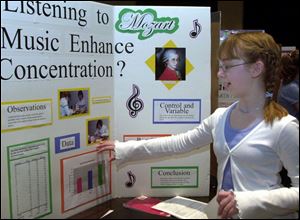
Kids come up with unlikely research projects for Science Day competition
3/23/2003
Bridget Brassell, 13, a student at St. Joseph's School in Maumee, explains how Mozart's music aids concentration.
Dog drool, popcorn, paintball guns, and parakeets.
Many youths who participated in northwest Ohio's 61st annual Science Day competition yesterday had fun going beyond the traditional nitrates-in-water research, exploring some of the light-hearted ways in which science is part of our daily lives.
No harm in that. “It's the enthusiasm for science that makes me feel good,” Dr. Mark Camp, district event director, said.
Dr. Camp is a geology professor at the University of Toledo, where the competition was held. It drew 300 projects from 7th through 12th graders who attend schools in Lucas, Hancock, Wood, Ottawa, and Seneca counties. Sixty-four of the students were chosen to represent the region at the state competition on May 3 at Ohio State University. The event is sponsored by the Ohio Academy of Science.
Consider the research of two young competitors, Lindsay Talkington, 13, and Carolynn Smith, 14. The two eighth-graders at Christ the King School, both animal lovers, compared saliva samples of humans to those of dogs, cats, and rabbits. Their conclusion: Man's best friend has the freshest mouth. Humans are second, followed by cats and rabbits.
The girls said they scoured the Internet for supporting information and interviewed Lindsey's uncle, a dentist in Daytona Beach, Fla. The latter was not at all surprised that dogs edged out humans, they said, because dogs have a special acid in their mouths which neutralizes many germs.
Although humans use toothpaste and mouthwash to keep theirs in check, many don't know that another popular product - beer - makes a small contribution to oral hygiene by killing germs too, they said.
Fields such as botany, physics, medicine, engineering, environment, and behavioral sciences were studied in imaginative ways, with testing procedures and results posted on display boards.
One board explained why popcorn tastes better when stored in the freezer. The drawback: It results in a smaller yield. Another explained why compressed nitrogen fires paintballs with greater accuracy than compressed oxygen, but states that oxygen is more affordable. Neither had an advantage over the other in terms of distance.
Erin Scully, a 15-year-old sophomore at Sylvania Southview High School, is a bird-lover who studied the mimicking habits of parakeets. Her conclusion: They're easier to teach when humans interact directly with them, rather than playing recorded messages. “Birds are very social creatures,” she said.